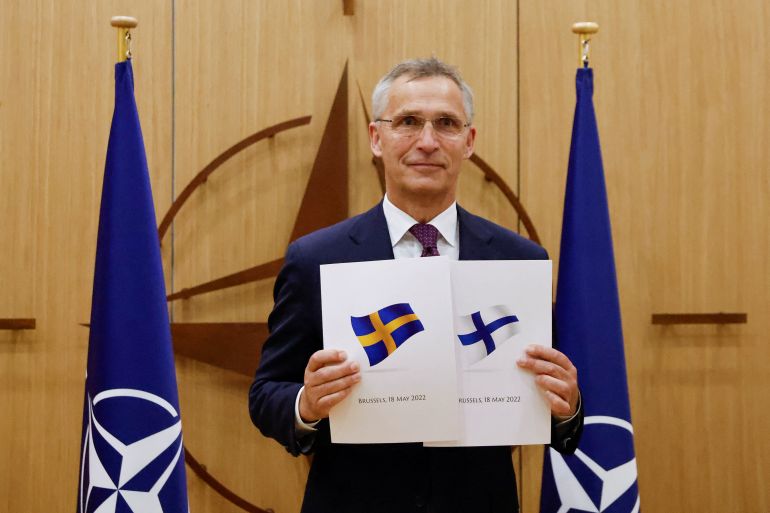How long will it take for Finland and Sweden to join NATO?
And what does the process involve?

As the Ukraine war rages, Finland and Sweden formally applied to join NATO on Wednesday, heralding an end to decades of neutrality.
Finland’s parliament had already voted overwhelmingly in favour on the matter. In Sweden, a majority of legislators back the application, including those from the ruling Social Democratic Party who had for decades opposed such a move.
Keep reading
list of 3 itemsSweden announces NATO bid, ending its historic neutrality
Will Finland and Sweden joining NATO make Europe safer?
A NATO foreign ministers meeting in Berlin on Sunday promised a swift process.
But how exactly does a country become a NATO member, and how long might the process take for Finland and Sweden?
Although NATO’s membership process is not formalised, and the phases can vary, the first step is usually set in stone: a country must declare its interest and officially express the desire to join.
NATO will then enter into discussions with the actor in question.
In this case, Sweden and Finland will then have to meet the criteria set out in the alliance’s 1995 “Study on Enlargement”.
NATO says these criteria include a “functioning democratic political system based on a market economy; fair treatment of minority populations; a commitment to resolve conflicts peacefully; an ability and willingness to make a military contribution to NATO operations; and a commitment to democratic civil-military relations and institutions.”
According to Alexander Lanoszka, assistant professor in international relations at the University of Waterloo, “Finland and Sweden have long met the basic requirements for being in NATO, not least because of the strength of their democratic institutions and strong civilian control over their militaries.
“As such, the process for joining should be speedier and thus smoother than what might have been the case with those countries that were under communist rule during the Cold War.”
‘Relatively straightforward’
Whether a country meets the requirements is assessed at the beginning of accession talks with NATO.
In some cases, countries are initially invited to participate in a so-called “Membership Action Plan” (MAP), a sort of preparatory programme in which a state is intensively advised and supported by NATO, so that it can meet the accession requirements in the future.
Bosnia and Herzegovina are currently at this stage.
However, for Sweden and Finland, membership is relatively straightforward, Alistair Shepherd, senior lecturer in European Security at Aberystwyth University, told Al Jazeera.
“Both fulfil the political, military and economic requirements. Both states are democracies with excellent democratic credentials, and both have advanced military capabilities that are already interoperable with NATO standards and states,” he said.
“Both have the resources to contribute to NATO’s budget. In summary, both are seen as adding value to NATO and its security, not weakening it.”
To initiate official accession talks, Sweden and Finland must be invited by NATO.
And all NATO members have to vote unanimously in favour of the candidates for this to be possible.
Analysts said this is highly likely despite the latest news that Turkey is opposed to the new potential members.
“There have been some rumblings of discontent or even objections in Hungary and Turkey, but in the end, they will accept their membership of NATO,” Shepherd noted.
Once the invitation is received, official accession talks are held at the NATO headquarters in Brussels, followed by meetings with Sweden and Finland.
Then, declarations of commitment are sent in which they agree to fulfil NATO obligations.
In some cases, potential candidates must indicate a timeline if reforms are required, to meet all eligibility criteria.
NATO then prepares for the adaptation of its treaty by means of the accession protocols, which have to be ratified.
“All members, including the candidate countries, would need to ratify their joining the Washington Treaty according to their own national procedures. In the case of the US, which is where the Washington Treaty is deposited, that requires a two-thirds majority in the Senate,” Lanoszka explained.
‘Fast-tracked’ applications
How long the process takes can vary significantly, depending on reforms required and the ratification of accession protocols by all 30 members.
For instance, the latest NATO member, North Macedonia, received its invitation in July 2018 and officially joined on March 27, 2020 – almost two years later.
However, NATO officials have said the Nordic countries’ membership procedure could be completed “in a couple of weeks”, while Stoltenberg said both applications would be “fast-tracked”.
For security reasons, there is a level of urgency involved given Russia’s warnings.
One of Russia’s stated reasons for invading Ukraine was its opposition to possible NATO expansion. After Finland and Sweden made their NATO intentions clear, Moscow has threatened “retaliatory” steps.
“There is an urgency to keep the time gap between applying to joining and actually becoming a member as short as possible for fear of Russia taking some form of action before the Article 5 security guarantee comes into force as they become members,” Shepherd said.
According to the Associated Press, NATO officials have said the process could take mere weeks.
But doubts remain whether this ambitious timeline is feasible, given the formalities involved.
“The process will still take several months, and NATO as an institution will accept their applications at their summit at the end of June in Madrid. But then, every existing NATO member state must ratify Sweden and Finland’s membership application,” noted Shepherd.
“This will take some time and will vary depending on the rules in each member state. It is likely to be late 2022 at the earliest when this is complete,” he added.